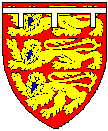
Back to the Glossary Contents.
Lions have always been very popular in heraldry: presumably the knights wanted to suggest they had the strength etc. of a lion...
One of the best known shields of all with lions is that of English kings, first borne by the Plantagenets in the 12th century – gules, three lions passant guardant or. This is seen with a label for difference in Thomas Brotherton’s arms.
For some reason lions guardant are sometimes referred to as leopards!
Lions are said to be armed and langued , that is clawed and tongued of a particular colour; if this is not explicitly stated, they are usually armed and langued gules [red], unless they or the field on which they appear is red, when they would be armed and langued azure [blue]. A lion is occasionally found disarmed, without tongue, teeth or claws.
Lions are drawn in a great variety of styles and shapes. They can be found in all manner of different positions on shields, although by far the commonest are passant or walking and rampant or rearing up; this latter is particularly suited to the shape of a shield. The lions frequently become distorted to fit into a shield, particularly if it is quartered! In early heraldry it is not always clear exactly which position is intended, and the arms may originally simply have been “a lion”, but differentiation between families soon meant that recognisably different lions were required.
There is a specialised vocabulary to describe the postures, mostly derived from mediaeval or Norman French.
Back to the Glossary Contents.
© Gill Smith 1997, 1998